Four More of my Favorite Plants and Why you’ll Love these too!
Today is Part Two of My Favorite Flowering Plants series. If you haven’t read Part One yet, go ahead and do that here: My Favorite Flowering Perennials Part 1. Today, I’ll add four more that I love and grow in my own garden.
Prickly Pear Cactus (Opuntia spp.)
Kind of a strange choice for a favorite flowering perennial to grow in my Connecticut garden, you say? Believe it or not, Eastern Prickly Pear (Opuntia humifusa) is a Connecticut native! Although we’re at the northern end of its native range, Opuntia can be found in CT. However, it’s listed as “of special concern” because the habitats where it was historically abundant (sandy coastline) have been so densely developed that it’s being pushed out. The farther north you go, the less prickly pear you’ll find.

Why I Love Prickly Pear
The flowers! Oh, those GORGEOUS, ruffled, bright yellow flowers in June and July! They’re absolute bee magnets, and each year, it expands and produces more and more. That’s not to say it’s unruly, it’s a very well-mannered plant that expands in its own little clump.
Unfortunately, the flowers don’t last very long, but it has them in abundance and is worth growing just for the annual show, especially since, like most of my other favorites, it requires almost no care.
You’ll also see the bright red fruits that come after the flowers, and these often stick around until the following spring, giving a nice little pop of color to the plant. Apparently, they’re edible, but I’m not that brave.
If you’re not part of my email list but would like to be added, you can go here to check out what’s available to my subscribers in my FREE Resource Library and sign up. You’ll also receive a weekly newsletter with happenings around the blog, but no spam, ever, I hate it as much as you do! Also, if you’ve been looking for a Printable Garden Journal that has everything you need, check mine out here.
How Does a Cactus Survive the Cold?
You might be wondering how in the world the prickly pear can survive subzero temperatures. It’s pretty ingenious, and something you’ll see in action if you have one.
In the fall, when frosts start coming regularly, you’ll notice your prickly pear shrivel up. It will look absolutely horrible, all wrinkly and dead. That’s ok.
Because cacti store large amounts of water in their pads (leaves), they aren’t typically cold-hardy. That stored water would freeze and burst the plant’s cells, killing it. However, prickly pear essentially dehydrates itself in response to cold temperatures, protecting its tissues from bursting.
Once spring comes and the weather warms, it will plump itself back up and go on growing like nothing ever happened. Cool, huh? Just be aware of this so you don’t get rid of the “dead” pads in the winter. They’re not dead, they’re just hibernating!
Varieties of Prickly Pear
There are more than two dozen varieties of prickly pear suited to different areas of the country, so you’ll want to do some research to find the one that’s just right for you. Sorry, my cold climate friends, this one isn’t going to be the plant for you in zones colder than 4b (unless you have a greenhouse!).
Planting and Care of your Prickly Pear (Opuntia humifusa)
As you might guess, being that it’s a cactus, prickly pear likes lots of sun and very well-drained soil. It’s not the kind of plant you’ll want to subject to regular irrigation, although it managed to survive a VERY wet and humid summer here last year without missing a beat. I do have it right next to our stone wall and driveway where the drainage is really good, so that probably helped.
There’s a Reason it’s called “Prickly”
You can see the spines on the prickly pear without any difficulty. Beware, however, those aren’t what you need to watch out for!
In the same vicinity of those large, nasty-looking spines are some much nastier little critters called glochids. These look like little hairs but they’re not. They’re sharp and pointy and barbed, and if you get them in your skin, they’re a complete bugger to get out and they HURT (not that I’d know this from experience or anything).
My point? If you’re planting or moving your Opuntia, wear leather work gloves. PLEASE. TRUST ME ON THIS.
This post contains affiliate links. When you make a purchase through one of these links, I receive a small commission. This does not affect your purchase price.
Columbine (Aquilegia spp)
Another favorite of mine is the Columbine. Columbines are, again, super easy to grow and they bloom beautifully! They come in so many different varieties and colors, you can pick almost anything you want. If you’d like to see just a few of the varieties available, you can do that here.
Columbine Planting & Care

As with my other favorites, columbines don’t require any coddling to grow and produce gorgeous flowers. They’re happiest in Zones 3 through 8.
Typically, you want to plant your columbines in full sun. However, if you live in the southern limits of their range, they will appreciate some afternoon shade. A nice layer of mulch will keep the roots cool as well. In the north, mulch will help them survive the winter. So, basically, mulch your columbine!
Other than that, being sure your soil is well-drained is about all you have to do. They really are that easy!
Columbines WILL reseed & Interbreed!
Columbines interbreed very, very easily. If you grow more than one variety (and who wouldn’t?), it’s likely that they’ll crossbreed and you’ll end up with something entirely different from what you started with when the new seeds sprout. I love, love, LOVE this characteristic because I never know what I’m going to get, and they’re always beautiful.

However, if this isn’t something you want, you can either plant just one variety (but, again, what fun is that?) or be sure to clip and dispose of the seedpods when they develop.
If you don’t allow your columbines to reseed, however, be warned that, although perennials, they are short-lived. Each individual plant will only last 3 to 4 years, and they don’t bloom until their second year. If you do let them reseed, however, you’ll have an endless supply of columbines, and if you don’t like where they pop up, you can always transplant them.
Columbine Pests
This is going to be a short paragraph. The only pest they’re known to be troubled by is the leaf miner. Honestly, mine get leaf miners every summer (you can see the little silver trails they make in the leaves), but I don’t bother doing anything about them. They don’t bother the plant, and they don’t even really disfigure it, so I don’t mess with things.
I have seen critters on the seed pods later in the summer. I can’t tell you what they are because I don’t know, but I figure if they’re eating my columbine seeds, they’re not eating something else more valuable, so I don’t mess with them either, other than occasionally clipping the heavily-infested seed pods off and disposing of them.
Butterfly Weed (Asclepias tuberosa)

I love butterfly weed for its beautiful orange flowers and for the fact that all the insect pollinators in my garden seem to love it. Once it blooms, it’s continually covered with bees, hoverflies, butterflies, you name it.
It’s also a food source for monarch caterpillars, as it’s in the same genus as milkweed. However, it doesn’t contain the irritating sap that milkweed does. If you’d like to read another post where I talk about milkweed and butterfly weed, you can read my Sowing Seeds of Thanksgiving post here.
Care of Butterfly Weed
You’re going to get tired of hearing this, but this is another plant it and forget it type of flower. Make sure it’s not in soggy soil, and grow it in Zones 3 through 9 (it’s native throughout much of the US), and that’s about it.
It can take a bit to get established and might need a year or two to start flowering, but it’s another super easy-grow plant with big rewards. You can also find yellow-flowered varieties, if you’d prefer.
One Butterfly Weed Warning
As I allude to in my Sowing Seeds of Thanksgiving post, butterfly weed, along with its cousin, milkweed, reseeds readily, freely and prolifically. If you don’t want it to do that, you MUST cut off and dispose of the seed pods before they split open in late summer to early fall. Don’t worry, they’re huge and easy to see (there’s a picture of them in the Sowing Seeds of Thanksgiving post).
Again, I leave mine alone because I figure anything that’s good for the butterflies and bees is good for me too, but if you have a more formal garden, you’ll want to control them.
Morning Glories (Ipomoea spp)
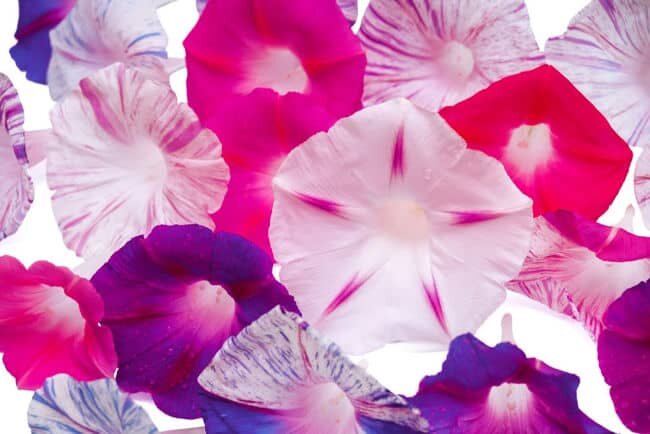
This is the only one of the plants I’ve talked about in this post that isn’t *technically* a perennial, but they come back each year from seed, so I figured you wouldn’t mind if I included them here.
Why I Love them (but not everyone does!)
Morning glories seem to be one of those love ’em or hate ’em kinds of plants, so I know they might be a bit of a controversial choice. I personally love them because I think the flowers are stunning, but I’ve been in gardening Facebook groups with people who absolutely hate them.
They do reseed prolifically and come back every year, but I haven’t had any trouble with them taking over or causing a problem. I don’t know if that might be because I always pick heirloom varieties or not. Just please keep in mind that they can be quite prolific if you do decide to grow them.
Planting & Care of Ipomoea
Morning glories aren’t frost-tolerant and like warm soil, so please don’t plant the seeds outside until 2 weeks after your last frost when the soil is above 65F. You can also start the seeds indoors 4 to 6 weeks before your last frost to give them a head start.
Be sure to soak your seeds for 24 hours before planting or nick them with some sandpaper as they’re very hard and this will help with germination.
Be sure that you’ve given your morning glories lots of room to grow, as the vines can get up to 15 feet long! You can see what I’m planting them on this year in the picture below. You can’t really see them in the picture, but there are flower boxes just at the base of the lattice on the inside.
This is the first year, and I can’t wait! I’ll definitely update with a picture once they’re flowering!
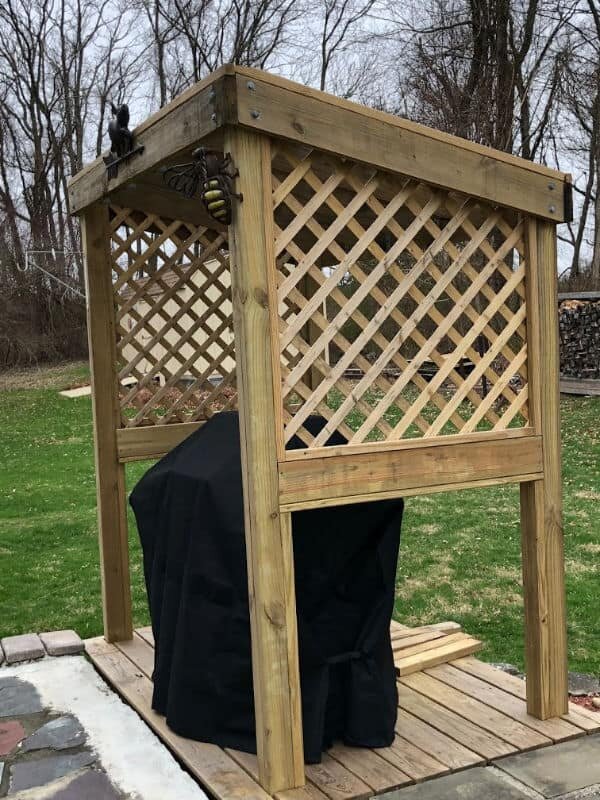
As with any other plant, being sure that they get sufficient water (about 1″ per week) and a nice layer of mulch once they’re growing is important. Other than that, your morning glories don’t need anything and actually prefer poorer soil. Just be sure the soil is well-drained, and away they’ll go.
NOTE: Morning glory seeds are poisonous. They won’t kill you (or your kids or pets), but they do contain a substance similar to LSD and thus, can cause similar effects if a large quantity are eaten. If you have kids or curious cats or dogs, just be sure to keep the seeds away from them.
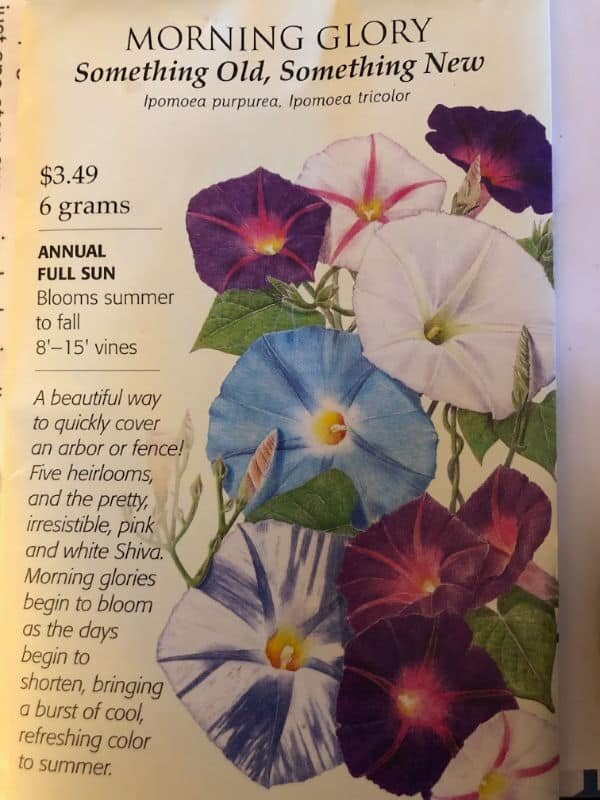
Again, as I mentioned last week, I’m not necessarily advocating growing every one of these plants in every garden. You should always do your research before purchasing or planting any new plants to make sure they are a good fit for your garden and your area and, most importantly, to make sure they aren’t listed as invasive in your area of the country. I don’t think any of the four I’m talking about today are, but it doesn’t hurt to check anyway.
I hope you’ve enjoyed this second installment of my favorite flowering plants, and that you’ll give some of them a try in your garden this year. If you do, please check back and let me know how it went. And, don’t forget to pin a couple of the images below to your Pinterest boards so you remember to come back!
As always, smile and have a crazy organic day!
Posts Related to My Favorite Flowering Plants Part 2
- The Last Garden Journal You’ll Ever Need
- Favorite Flowering Perennials Part 1
- Sowing Seeds of Thanksgiving
- Shrubs to Attract Beneficials
- Subscribers Resource Library

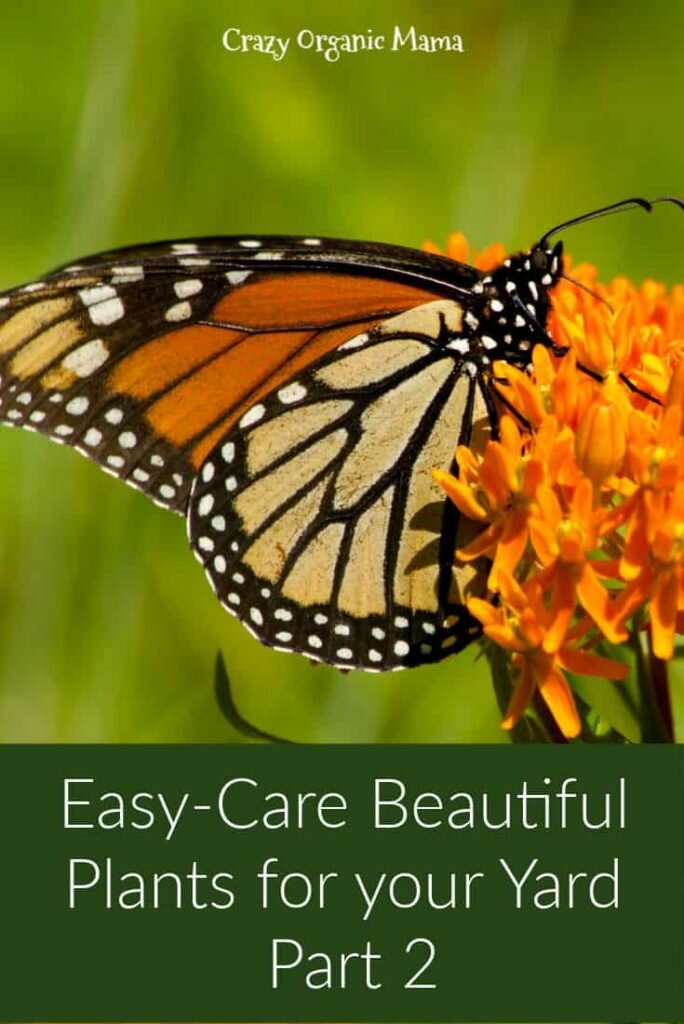
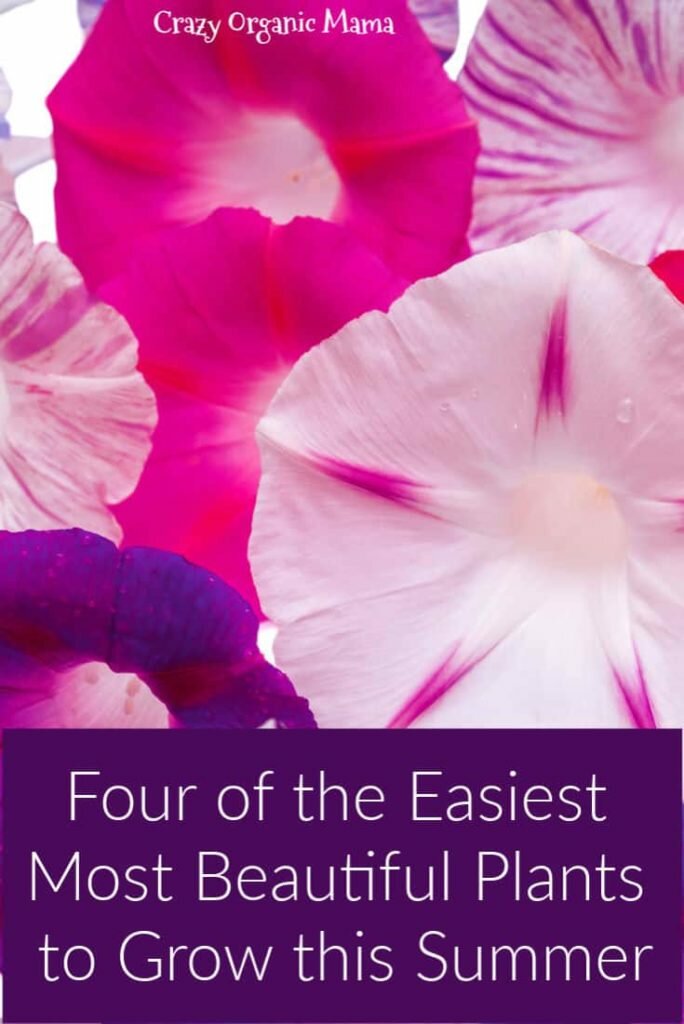
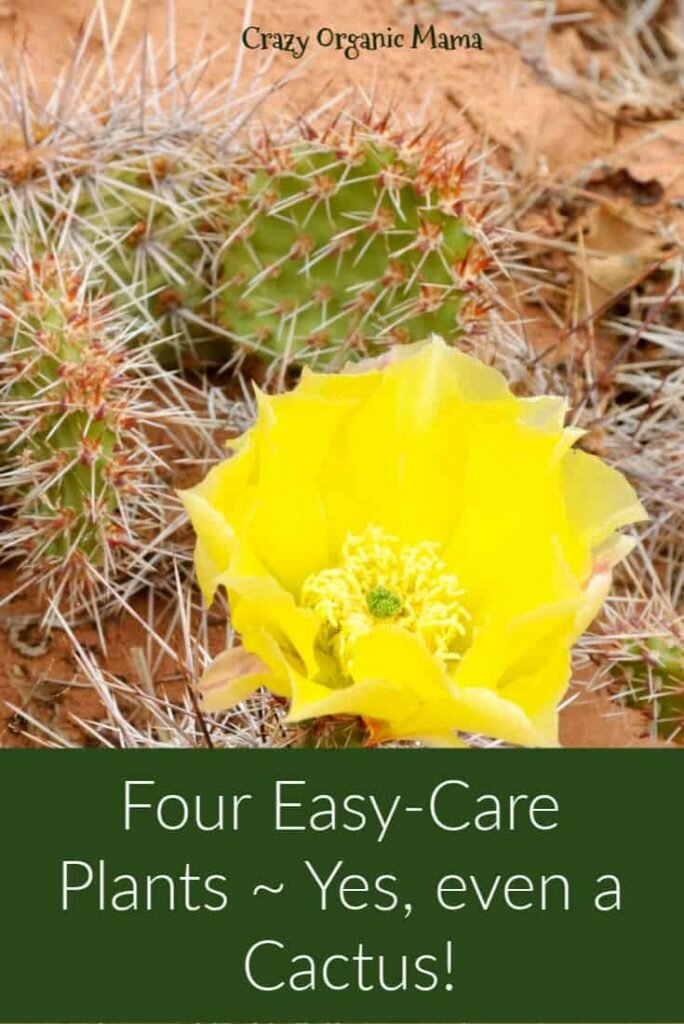


4 comments
Love morning glories as they’re one flower I’ve managed to keep alive year after year, lol! Did not know that the seeds were poisonous though -and I also thought they were perennials. When I was a university student I had a beautiful “wall” of morning glories growing up a chainlink fence right outside my window. I lived in that house for four years and each year they came back thicker and more stunning than the previous one. Thanks again for another gorgeous and informative post!
Glad you enjoyed it! They may as well be perennial as they reseed so prolifically. Some people find them obnoxious for that reason, but I love them!!!
Well, that is so interesting about the prickly pear! First of all that it even grows in CT and then that it dehydrates itself for winter.
I can’t wait to see your updates on the morning glories.
🙂 gwingal
They’re going crazy upstairs in my plant room at the moment! I have heard that it can be tough to start them from seed so I started a whole bunch. They ALL came up! Oops!! Don’t worry, I’ll figure out something to do with them.